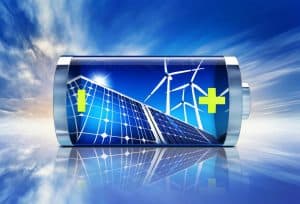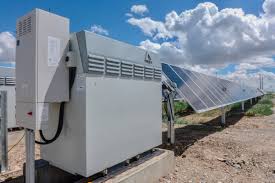The future generation of batteries

New batteries made from everything from lithium-ion (li-ion) + cobalt, phosphate, manganese, and silicon; as well as batteries based on vanadium, zinc, sodium, or even graphene – all show great promise. Advanced R&D is being done on "superconductors", flow batteries, solid-state batteries, and various metal or air-flow type batteries. Emerging experimental battery combinations include lithium-sulfur, lithium-nickel-manganese-cobalt, and lithium-tininate oxide.
New advanced next-gen batteries are quickly gaining ground both in terms of R&D, as well as deployment. Advancements in next-gen batteries will help add renewable energy storage to the grid, add charging capacity to our cell phones and laptops, and help extend the range of electric cars to compete with gasoline ones.
Next-generation batteries
Li-ion batteries are being developed, and some are currently in the marketplace, which have increased efficiency, often while cutting costs. The latest generation of EV and grid-scale storage batteries have a higher capacity, a higher efficiency, and are longer-lasting than standard lithium-ion batteries.
Advanced next-gen batteries can charge, recharge, and discharge quickly. New varieties of advanced batteries (in R&D) last with a high capacity for 20+ years and can charge in minutes. The most common type of high capacity, widely used, advanced batteries being developed today are lithium-ion batteries made in combination with other metals or other elements; creating a new battery technology, like li-ion cobalt oxide.
A few other examples of advanced li-ion next-gen battery technologies currently on the market (but less widely commercially available than li-ion cobalt varieties, or even lithium-iron-phosphate batteries, which are currently a popular battery solution for some stationary battery applications) include: lithium iron phosphate, li-ion silicon, li-ion manganese oxide, li-ion sulfur, and li-ion solid state. (Here is a YouTube video on li-iron phosphate batteries).
The best-in-class batteries based on advanced li-ion chemistry are more efficient, greener, lighter, longer-lasting, often rechargeable; and have a higher capacity than conventional batteries. Advanced next-gen li-ion batteries could revolutionize battery technology for smartphones, computers, tablets, electric vehicles, grid storage, commercial/ municipal buildings, RVs, boats, aerospace applications, other industrial applications, and much more.
Today, mass-produced li-ion batteries (such as li-ion cobalt oxide) remain the most prominent high-capacity battery in today’s market for smartphones, laptops, and electric vehicles; as well as small-scale (residential/ commercial building), and large-scale (grid, industrial) energy storage.
However, sodium-ion batteries, graphene-based batteries, and zinc-air batteries, represent cheaper, more abundant materials than lithium. These advanced batteries could produce a less expensive battery, with possibilities for long-term energy storage n in the future; if R&D in these technologies is successful.
Lithium-vanadium phosphate batteries are a next-generation battery solution that shows promise, as they can extend the range of electric vehicles (EVs), for example. These batteries potentially have greater power than batteries found in the latest electric vehicles (such as lithium-manganese oxide), but also greater safety than the batteries found in smartphones and laptops.
In addition, recharging lithium-vanadium batteries could be faster than batteries currently used in EVs and computers. Other promising advanced next-gen battery types with varying degrees of research and development, and at different levels of marketability, include flow batteries.
Flow batteries

Flow batteries, such as vanadium flow and zinc-iron redox flow, have a longer battery life than conventional, or even li-ion batteries. Flow batteries have a battery life of over 20 years, quickly charge and discharge, and easily scale up from under 1 MW to over 10 MW.
Vanadium flow batteries represent high-capacity energy storage, can be idle when solar and wind aren’t producing, and then discharge instantly. They have the unique ability to charge and discharge simultaneously and to release large amounts of electricity quickly.
As they are inexpensive to scale up, vanadium flow batteries represent an opportunity for reliable, affordable large-scale energy storage. At this point, flow batteries are still mostly stuck in the R&D phase due to the expense of manufacturing these batteries; with only limited commercial availability. However, commercial deployment of flow batteries is seen in some areas worldwide today, including some large markets - such as throughout Australia and Asia.
Air batteries
Unlike vanadium flow batteries, which currently represent a great, realistic battery alternative, lithium-air batteries only theoretically represent a great battery alternative. Lithium-air batteries could triple the range of EVs, and could give fully charged EVs the same range as maximum-range gasoline cars with a full tank. However, whereas vanadium flow batteries can charge and discharge repetitively with no problem, lithium-air batteries have been notoriously difficult to recharge.
Cobalt controversy
One glaring issue with li-ion batteries is the lack of sustainability in sourcing the critical rare earth metals used in li-ion batteries. Especially problematic is cobalt sourced from Congo (cobalt is frequently found in li-ion batteries in EVs, mobile phones, laptop computers, and other electronic products).
Cobalt sourced from the Democratic Republic of Congo (which supplies roughly 2/3 of the world's cobalt), and then used in li-ion cobalt oxide batteries (as well as other batteries - for issues such as battery durability and the like) are unsustainably and unethically sourced. Cobalt from Congo is the product of cobalt mining rife with human rights abuses (child labor, labor for insufficient wages, labor in hazardous, unregulated conditions), unmitigated environmental and social injustices, and other unsustainable practices.
Cobalt is found in many varieties of li-ion batteries, in nickel-based batteries, and in other batteries that use a combination of metals and elements. However, there are batteries with no cobalt or other unsustainable rare earth metals (such as those promising emerging advanced battery types mentioned above in this article).
Please also see: